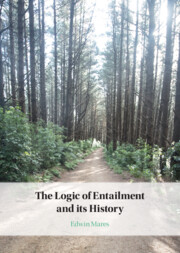Book contents
- Frontmatter
- Dedication
- Contents
- Preface
- Acknowledgements
- Table of Symbols
- 1 Why Entailment?
- Part I Entailment in the Twentieth Century
- 2 C. I. Lewis and His School
- 3 Entailment and Possible Worlds
- 4 Entailment and Relevance
- 5 Reflexivity
- Part II Theories and Entailment
- 6 Theories and Closure
- 7 Theories of Entailment
- Part III The Logic E of Relevant Entailment
- 8 The Logic of Entailment
- 9 Negation and Disjunction
- 10 Quantification
- 11 Entailment and Reasoning
- Appendix Systems, Semantics, and Technical Results
- References
- Index
7 - Theories of Entailment
Published online by Cambridge University Press: 08 February 2024
- Frontmatter
- Dedication
- Contents
- Preface
- Acknowledgements
- Table of Symbols
- 1 Why Entailment?
- Part I Entailment in the Twentieth Century
- 2 C. I. Lewis and His School
- 3 Entailment and Possible Worlds
- 4 Entailment and Relevance
- 5 Reflexivity
- Part II Theories and Entailment
- 6 Theories and Closure
- 7 Theories of Entailment
- Part III The Logic E of Relevant Entailment
- 8 The Logic of Entailment
- 9 Negation and Disjunction
- 10 Quantification
- 11 Entailment and Reasoning
- Appendix Systems, Semantics, and Technical Results
- References
- Index
Summary
This chapter generalizes the ideas given in the previous chapter. It sets out the notion of a model based on a set of theories. One of these theories is the logic itself. It is, so to speak, the correct theory of theories. It correctly states the principles under which all the theories (including itself) are closed. But each theory has associated with it a closure operator. Some of these operators get the principles of theory closure quite wrong in the sense that they do not apply correctly to every theory in the model. The interaction between these closure operators can be altered in various ways, giving rise to different logical systems. The resulting formal semantics can be represented in the manner of Kit Fine’s “Models for Entailment”.
Keywords
Information
- Type
- Chapter
- Information
- The Logic of Entailment and its History , pp. 136 - 154Publisher: Cambridge University PressPrint publication year: 2024
